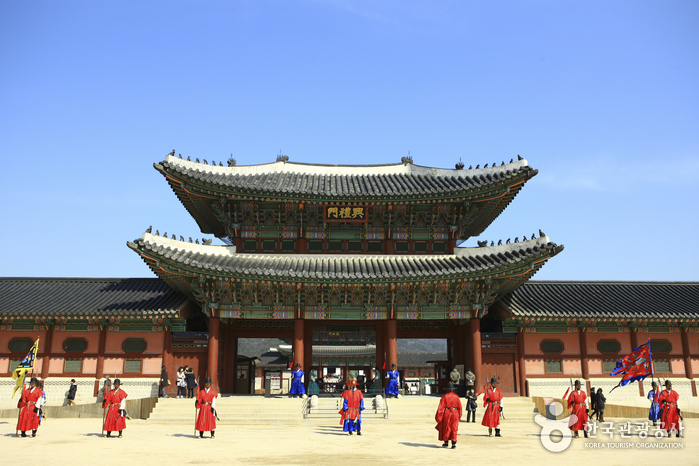Attraction information
Address Seoul-si Jongno-gu Sejong-ro 1-1
Directions Take Seoul Subway Line 3 to Gyeongbokgung Station and use exit #5.
Admission fee Adult: 3000 won; Child: 1500 won; persons aged 6 or under: free
Check out this site for more info: http://visitkorea.or.kr/enu/SI/SI_EN_3_1_1_1.jsp?cid=264337
Originally built in 1394, Gyeongbokgung (경복궁), or “Palace of Shining Happiness”, is a royal palace located in northern Seoul – in fact; it was the main and largest palaces of the Five Grand Palaces built during the Joseon (조선) Dynasty.
The Rise and Fall of Empire
The palace has endured a turbulent history, and has faced destruction on numerous occasions by the Japanese. It was continuously expanded under the regime but much of it burned down during the Japanese Invasions of Korea in the 1590s. In 1867, the Korean royal family reconstructed the palace, creating a huge complex with 330 buildings and 5,792 rooms, becoming a symbol of majesty for both Korea and the regime. During the Japanese imperialist expansion period, Japanese agents assassinated Empress Myeongseong in 1895, and afterwards, her husband, Emperor Gojong (고종), left the palace and never returned. The Korean Empire itself ended when Korea was annexed by Japan in 1910. During the Japanese occupation of Korea, the Japanese government eradicated the symbol and herit-age of the Joseon Dynasty by demolishing all but 10 buildings of the palace. The Japanese General Government Building for the Governor-General of Korea was built in front of the palace as well.
Today, the palace is open to the public, and houses the National Folk Museum of Korea and the National Palace Museum of Korea. The restoration project will continue for another 20 years to restore Gyeongbokgung into its former status.
Places of interest
The palace remains one of the most representative artifacts of the Joseon Dyn-asty. One of the places I visited when I went to Seoul in 2007 was the Gyeonghoeru Pavilion, a hall used for important state banquets. The first Gyeonghoeru was first constructed in 1412, but was burned down by the Japanese in 1592. The present building was built in 1867 on an artificial lake. Three stone bridges connect this building to the palace grounds. The corners of the island are decorated with sculptures of the 12 Zodiac animals. Hyangwonjeong is another scenic attraction. It’s a pavilion constructed on an arti-ficial island of a lake called Hyangwonji, loosely translated as “Pavilion of Far Reaching Fragrance”, and connected to a wooden bridge called Chwihyanggyo, or “Bridge Intoxicated with Fragrance”. The bridge was destroyed during the Korean War and was rebuilt in 1953.
Also to visit is Geunjeongjeon, the throne hall of the palace, where the king greeted ambassadors and gave important declarations. As with Geyonghoeru Pavilion, the Japanese burned down the original build-ing in 1592, and the present building was built in 1867. This building sits on top of a two-level platform, decorated with sculptures of imaginary and real animals. The stone-paved courtyard is lined with two rows of rank stone, called pumgyeseoks, which indicated where officials had to stand according to their rank.
Gyeongbokgung is definitely a great place to visit and understand more of Korea’s rich heritage. During your visit, you might even see some costumed imperial guards!


No comments:
Post a Comment